My heart is so heavy for this beautiful developing country. Please give anything you can. Help Nepal heal.
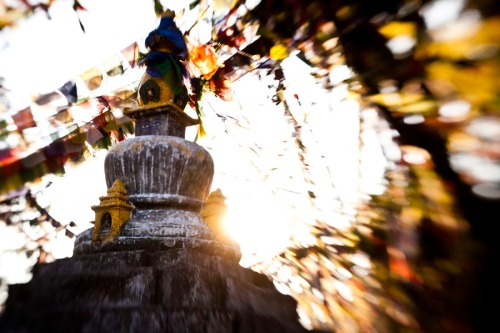
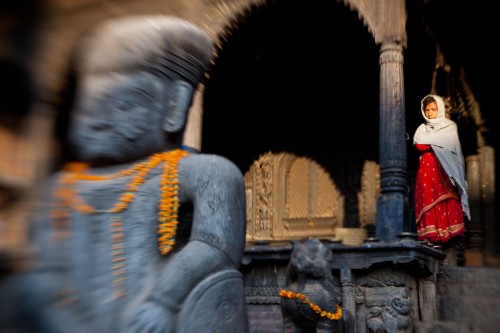
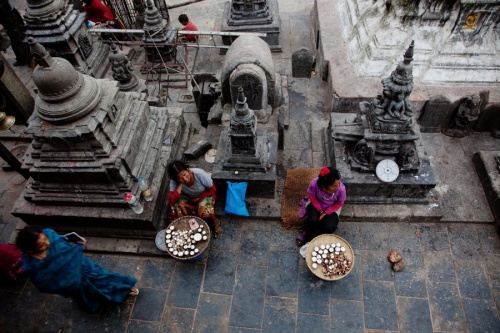
My heart is so heavy for this beautiful developing country. Please give anything you can. Help Nepal heal.



Filed under Inspiration
by Frank Langfitt
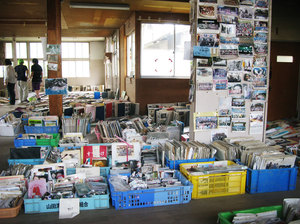
Each week, tsunami survivors gather at temporary housing centers in the city of Yamada along Japan’s northeast coast. They sing songs to cheer themselves up and comb through salvaged photos.
One morning, Miyoko Fukushi finds an old picture from the opening day of her daughter’s elementary school. It’s a formal shot of the students’ mothers, wearing kimonos with their hands in their laps. Fukushi, 77, points to a younger version of herself.
“I was chubbier when I was young,” she says with a laugh.
Then she points to other women in the picture, who lost their lives in the deluge.
“Kayo Suzuki. She was washed away as she ran from the tsunami,” Fukushi recalls. “This is Kayoko Kon. I heard she went back home to get her belongings.”
Last March’s tsunami devastated the coast here. If people didn’t lose their lives, they lost practically everything else — except, it turns out, many of their photos. Survivors found countless pictures strewn amid the mud and wreckage, many badly damaged by water.
Over the past several months, All Hands Volunteers, a Massachusetts-based, nonprofit, has done everything from repairing homes to cleaning drainage ditches along the coast. The organization has also hand-cleaned more than 55,000 photos. In some cases, professionals from around the globe have even restored images digitally.
Fukushi’s photograph needs work. Specks of dirt are embedded in the surface, and saltwater has washed away some of the figures.
“It’s a shame that damage has gone up so far on this lady, but most of her face is there,” says Becci Manson, a volunteer with All Hands, as she examines figures in the picture.
Ordinarily, Manson works in New York retouching images for magazines like GQ and catalogs for Barneys. When she saw all of the damaged photos here, she saw another way to help.
Manson has traveled more than an hour up the coast today to pick up and return photos. She takes Fukushi’s picture, scans it onto her laptop and uploads the image to a server. Then, she turns to scores of volunteers — from Sydney to Spain — to see who’s available to restore it.
“I’ll send an email out to all the retouchers and say, ‘ I’ve got loads more images for you,’ ” says Manson, who travels from town to town with a portable scanner. “Those who write back and say they want a new one, I’ll start sending the images.”
Scores of photo retouchers have pitched in to help. In all, they have fixed more than 220 photos for nearly 60 families, Manson says.
One of the volunteers is Bob Whitmore. Whitmore used to work with Manson in New York and learned about the photo rescue project on Facebook. He has already restored two pictures and is working on a third from his home in Metuchen, N.J.
Sometimes, Whitmore has to restore people’s bodies, or backdrops have been blotted out by water. He uses Photoshop to restore a piece of clothing or reconstruct a room.
“Using the laws of perspective, if you’ve got a wall coming up and a ceiling coming over, you can kind of figure out where they should meet,” he says in a Skype interview.
Professionally, Whitmore spends most of his time making a glamorous world look even more so in fashion magazines, but he has always loved restoring people’s old pictures.
“It’s the most satisfying work I think I’ve ever done,” says Whitmore. “Taking old photos and breathing some life into them. Putting the color back in that was faded, or fixing spots that have been damaged. People just light up when they see something come back that they thought was gone.”
Cho Kikuchi certainly did. She lost all of the photos in her house to the tsunami, but a few survived in a Buddhist temple, including one of her late father and another of her late husband.
They were worn and scratched by the elements. Manson retouched the photos herself, good as new.
“I didn’t expect this would [be] so beautiful,” says Kikuchi, 75, admiring the restored photos while sitting in a temporary home the government has provided. Every time she sees Manson — who is about half her age — Kikuchi invites her in for tea and snacks.
Kikuchi has placed the restored prints in a small, wooden shrine in her tiny home where she honors her loved ones.
“In the morning, I give them water and tea with ice,” she says. “Then, I pray for them to please watch over me.”
Manson says responses like this make the work worthwhile.
She says it’s also gratifying for another reason: Photo retouchers are often criticized for distorting reality in fashion magazines.
“There’s always someone who’s got something to say about how thin someone is made or how flawless someone’s skin is and the effect it has on young women,” says Manson. “So when I set up the project, it was nice to think we could actually do something to help someone.”
There’s more to do. In Yamada alone, thousands of recovered photos are waiting to be reclaimed by their ow
i have the honor of being a part of this project. what an incredible gift to give. you can listen to the story on npr here.
Filed under Inspiration
by Evan Osnos
The Dalai Lama announced his retirement today, an event that will be duly recorded—and then all but ignored for the time being. It’s not that the many parties with an interest in this issue don’t agree with his decision to remove himself from the political hurly-burly of the Tibet movement. (In fact, that’s one of the few things on which both the Chinese and Tibetan government-in-exile might agree.) The problem is that, despite his persistent attempts to renounce his political functions and pave the way for a new generation of leaders who can govern without the emotional and religious baggage he represents, he simply looms too large over the Tibet conflict to be there and not there at the same time.
But the announcement is more significant than people might imagine: When it’s finalized, this will be remembered as the formal end of his five decades as head of state of the Tibetan government-in-exile. (Though, in fairness, no country in the world recognizes that government as such.) But he has always been known for far more than that. To his admirers, he is the icon of endurance, a guru, a post-political figure. To his critics: a manipulator, a ditherer, a “devil with a human face.” This announcement will not change the fact that he remains the senior religious leader of Tibetan Buddhism, and, as I wrote in a Profile last year, that neither he nor China nor Washington yet knows what will happen when he dies. (Chinese authorities recently reasserted their longstanding declaration that the Dalai Lama has no right to be reincarnated without the Communist Party’s approval.)
There has abundant speculation that his spiritual role might be filled in the years ahead by the Karmapa Lama, who was born in Tibet but fled to Dharamsala a decade ago. Now twenty-four, he has grown into a large, commanding figure who is often seated at the Dalai Lama’s side at public events. But when I interviewed the Karmapa last year, he was a surprisingly fitful figure: Internet-savvy, barred from traveling widely by Indian officials, some of whom suspect he is a Chinese spy, and deeply curious about the West. The notion that he might slip easily into the sandals of the Dalai Lama has always struck me as an unexamined proposition. (Further complicating the prospect of him taking over
is a swirl of controversy rooted in the fact that another man also claims to be the Karmapa.)
The emerging reality is that the Dalai Lama will never truly be able to give his power away. It must be earned, gradually and meaningfully, by the next generation of leaders, people such as Lobsang Sangay, a Tibetan legal scholar at Harvard who is a frontrunner to be the next prime minister in exile. Eventually, a new generation of leaders might help break some of the logjam with the Chinese government, though I’m not optimistic. The transition will not be swift, and it will not happen entirely until the Dalai Lama’s “change of clothing,” as he calls his own death. But today is the next step toward a change that he has sought for years.
I’ve often wondered, watching the Dalai Lama tinker with his mechanical toys or geek out with a visiting scientist over the details of brain science, whether, in some other scenario, he might have had a happy life as a bench scientist at a lab in Jersey. Now he might get a bit more time to himself. “Retirement is also my human right,” he once told an audience. They thought it was charming, and they giggled madly, as people always do in his presence. But the comment always sounded painfully sad to me. “Since sixteen years old,” he added that day, “I carried this responsibility.”
.
I always giggled in his presence. He deserves a break, but I miss him already. I know many will and many who have for a long time. A slightly scary beginning of an end. A hopeful beginning to another end.
Filed under Inspiration
by Lucy Craft


The Japanese have long endured crowded cities and scarce living space, with homes so humble a scornful European official once branded them rabbit hutches.
But in recent years, Japanese architects have turned necessity into virtue, vying to design unorthodox and visually stunning houses on remarkably narrow pieces of land. In the process, they are also redefining the rules of home design.
Few Americans would consider a parking-space-sized lot as an adequate site to build a house. But in Japan, homes are rising on odd parcels of land, some as tiny as 300 square feet.
Yet the term “house” doesn’t really do justice to these eye-catching architectural gems, fashioned from a high-tech palate of materials like glittering glass cubes, fiber reinforced plastic and super-thin membranes of steel.
More With Less
The need to do more with less space has sparked a boom in house designs that are as playful and witty as they are livable. One of Japan’s leading designers of kyosho jutaku, or ultra-small homes, is Tokyo architect Yasuhiro Yamashita.
“If you tried to build a normal house on a super-small plot of land, it would end up being really cramped. So in order to make the house as roomy as possible, we have to think up new structures and assembly,” Yamashita says.
Ultra-small homes conserve space by dumping conventional elements like entranceways, hallways, inner walls and closets.
Windows, in a variety of shapes and sizes, are scattered across a wall, or concealed near the base. A bathroom is separated by just a curtain. Furniture can be folded into the wall, allowing a single room to serve multiple purposes.
Designers indulge in fantasy, like asymmetrical walls, cantilevered floors, or cover their houses in a translucent skin, in order to exploit all available natural light.
Yamashita built a long, skinny, cathedral-like futuristic home on a sliver of land just 40-feet wide, and named it “Lucky Drops.”
“‘Lucky Drops’ was built on an extremely long and narrow space. So light could enter only from the ceiling,” Yamashita says, speaking in Japanese. “All the light comes in from the top. So the whole house becomes like a Japanese paper lantern.”
The boom in quirky small homes was fueled by new design and materials technology, which have slashed the price of a custom-built home by as much as two-thirds, making these homes affordable for singles and middle-class couples.
Minoru and Aki Ota, a couple in their 30s, reside in a home that sits on fewer than 500 square feet. The walls, floors and even the kitchen table are made entirely of precast concrete.
“We weren’t interested in a big house in the suburbs. We were happy to have a comfy place downtown. It’s not that we wanted to live in a micro-house, but it’s turned out to be plenty of room for two and convenient,” Minoru Ota says.
The home features narrow windows at ground level, strategically placed to reveal bits of scenery, and flood the house with light.
Washing dishes at the counter — it’s also made of concrete — Aki Ota says the house has proved warmer than they expected, but the novelty hasn’t worn off four years into their residence. She says it’s like living in an art museum.
Azby Brown, author of The Very Small Home: Japanese Ideas for Living Well in Limited Space, says the phenomenon’s impact on Japanese popular culture has been huge.
“Where the forms of these houses is very unusual, asymmetric, seemingly unbalanced or lopsided, it’s because there’s a room or certain functions that need to be accommodated,” Brown says. “And rather than make everything be symmetrical and line up, they just said, ‘Well, if this living room is just going to have to stick out, over the parking space, so be it.'”
The real genius of ultra-compact homes is the use of visual tricks that make tiny spaces appear roomier.
Thinking 3-D
“People tend to think of homes simply in terms of floor space. We architects think in 3-D,” Yamashita says. “Using all three dimensions, we can make a space look larger, and more functional. It becomes easier to devise ways of bringing in more light and air.”
“It’s kind of a psychological jujitsu,” Brown says. “That changes your sense of perception from the things that would make you feel claustrophobic perhaps, and rather focusing on the life and the people that you’re with.”
Super-small luxury houses might seem counter-intuitive to most Americans, who measure their floor space in the thousands of feet, not hundreds.
But Brown, who has lectured on the subject for New York City planners, says the techniques in Japan could offer lessons on how to comfortably house residents in other teeming cities.
“We are larger people physically than the Japanese, we do tend to need more space, we’re less comfortable in some sitting positions, like sitting on the floor, than most Japanese are. But I think we could also accommodate ourselves to it,” Brown says.
As for the Japanese, who have updated their small-house design based on traditions such as the teahouse, they haven’t just accommodated to ultra-tiny homes — they now revel in them.
.
I’m a big fan of the small house movement. Go small. Get creative. Less really is more.
Filed under Inspiration

We met some of the last generation of Tibeten refugees who fled Tibet after China’s invasion. Their hardships, their stories, their culture stay with them. And though in Nepal they cannot vote, they cannot buy land, and they have limited freedoms, they live. And their faith pours out in a glow of beauty.
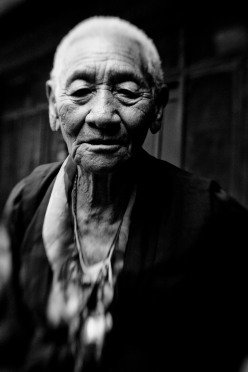
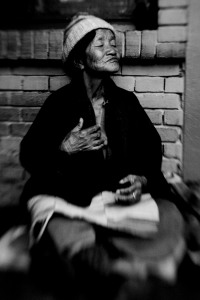

Filed under Inspiration

Quite a view from the top of 3210 meters at Poon Hill. Worth the 45 minute 430 am hike thanks to a pretty sunrise and Nepali tea ladies up top (60rp black tea/70rp milk tea). It starts with a few hundred people, so plan on staying an extra hour or two after everyone else leaves. Peace is worth the wait.
Filed under Inspiration
travel hiatus. my favorite kind.
we’re in nepal and india for the next four months, volunteering for VCD Nepal, Pencils of Promise, shooting a lot, playing a lot, and testing out olfactory fatigue.
india has gotten more expensive, but really, the dollar is just not what it used to be. not even since last spring. good thing we’re in nepal now, where spending twelve dollars tonight seemed like an extravaganza. great meals for a dollar or two. hotels for less than ten a night. had some delicious masala tea at the kathmandu guest house. saw a breathtaking view of the himalayas on the flight in (travel tip#1: sit on the left side of the plane flying eastward, right westward).
i’m looking forward to hanging out in the mountains, rolling around a bit in greens and blues, shooting what makes me happiest, being encompassed by a new culture, and potentially learning to not gag while eating lentils every meal.
more to come.
updates here and from two points of view at sojourner cafe.
Filed under Inspiration
by Adam B. Ellick
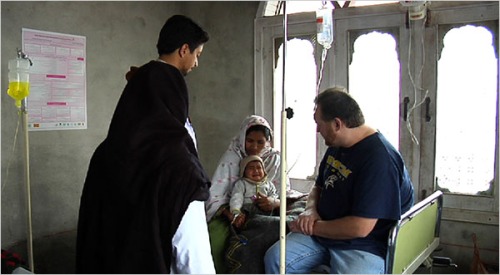
CHIKAR, Pakistan — The lone hospital in this Kashmiri mountain town was on the eve of hosting one of the year’s biggest social gatherings, a health fair for several hundred villagers, and Todd Shea was not happy.
The hospital’s founder, Mr. Shea, an American who resembles a football coach more than a health worker, was outraged because one of the employees had failed to purchase enough hygiene kits — freebies the villagers had come to expect at the fair.
“This is a problem, and there is a solution,” Mr. Shea, strident but good-natured, yelled to a staffer on the phone from the field. “Let’s see how good you are. I know there are kits lurking in the walls. I guarantee you that if I come there, I will find them. You know me!”
Seven hours later, at midnight, the employee returned from a nearby city with a sheepish smile and 100 kits he had managed to round up. Mr. Shea hugged him, “I believe in you,” he said.
If Mr. Shea, 42, had a résumé, it would by his own admission reveal far more experience as a cocaine addict than as a medical professional. But with his take-charge demeanor, he has transformed primary health care here in this mountain town in Kashmir, where government services are mostly invisible.
“Others are more qualified, but I’m the one who’s here,” he said.
Most recently, he has focused on the millions of people who have been uprooted by the army’s campaign against the Taliban, in the northwest.
But it is here that Mr. Shea spends his time and learned years ago that, as far as health care is concerned, every day is a crisis for Pakistanis.
He arrived as a volunteer rescue worker immediately after the 2005 earthquake that killed 80,000 Pakistanis. Overwhelmed by the community’s long-term needs Mr. Shea never left, and in 2006 he set up a nonprofit charity hospital called Comprehensive Disaster Relief Services, or C.D.R.S.
Humanitarian aid flooded the region in the immediate aftermath of the earthquake, but the tide of aid and government support ebbed within months, leaving 25,000 wounded residents without doctors, medical supplies and an actual health outpost. That is, life returned to normal.
In Pakistan, less than one percent of the national budget is devoted to the health of its citizens, and the nation’s health care crisis is especially acute in remote communities. “It’s frustrating and sad that’s the way it is,” Mr. Shea said. “But if I screamed from the mountaintop, it wouldn’t change a thing.”
So he does what he can. His hospital, with 38 employees and nearly $200,000 in financing from Americans and Unicef, highlights not only the needs of Pakistan’s rural health system but also a glaring vulnerability for a government trying to brand itself an alternative to the Taliban.
“The Taliban terrorize people, but they put forth logical arguments about the state’s failures,” said Shandana Khan, the chief operating officer of the Rural Support Program Network.
“It’s very common to see primary health care facilities without doctors, or medicines,” she added. “Doctors don’t want to be posted there. Or they’ll sign up and get paid, but sit in cities and no one monitors them.”
Chikar is only 85 miles from the capital, Islamabad, but it takes six hours up a switchback road to reach the hospital. Here, the government provides only 10 percent of the community’s medicine needs. C.D.R.S. picks up the rest.
Last year Mr. Shea recruited a doctor by doubling his government salary and offering him the only private room in the 20-room hospital, which he rents for $250 a month. Mr. Shea himself sleeps on a mattress in a room he shares with staff members.
“The things you see here are only because of C.D.R.S.,” said the doctor, Rizwan Shabir, 27, who had come from a practice in Muzaffarabad, a city of 300,000. “Frankly, without Todd, there would be no proper medicine, and patients would be dead.”
Still, C.D.R.S. is more makeshift than miracle. On a recent morning, Dr. Shabir treated 140 patients in five hours. Without blood-testing laboratories, he diagnoses common illnesses like hepatitis and tuberculosis through clinical evaluations.
Outside of Chikar, C.D.R.S. supplements 10 other regional government health outposts by paying salaries and purchasing medicines. Over all, it treats about 100,000 patients annually, and 70 percent are women and children.
With the global economic crisis, Mr. Shea says he fears that his group’s $200,000 annual budget may be difficult to raise for 2010. So he has proposed a community insurance program that would require a contribution of 31 cents per person per month, which would net $20,000 a month. He estimates that 65 percent of the town can afford it, and he hopes the government and private donors will pick up the rest.
Mr. Shea is an unlikely person to reform Chikar’s decades of medical neglect. When he was 12, his mother died of a Valium overdose. By 18, he was addicted to crack cocaine.
In 1992, he moved from his native Maryland to Nashville to pursue a music career, he said, and spent the next decade playing in bars and restaurants around the country. At one point, he was forced to sell his own blood plasma for $40 a week to pay the bills.
He moved to New York City in 1998, and had a gig booked at CBGB, the famed music club, on Sept. 12, 2001. As he watched the World Trade Center burn and fall, he said, he promptly emptied his band van and used it over the next week to ferry meals to firefighters at Ground Zero.
He soon became addicted to rescue efforts, and volunteered in Sri Lanka after the 2004 tsunami. It was his first time overseas. After Hurricane Katrina, he said, he volunteered with another rescue organization. Then the earthquake hit Pakistan, and he left for a country he knew nothing about.
Once in Chikar, he met a local M.B.A. student, Afzel Makhdoom, who had just dragged his aunt out from under the rubble of his home. As soon as he could scrape together the money, Mr. Shea hired him.
“I had never met an American before,” said Mr. Makhdoom, now 24. “My first impression was: They just want to kill Muslims; it’s an invasion, and they’ll never go back home. But now we want to keep this American here.”
[video: The Improbable American]
Filed under Inspiration


Insects are quite popular munchies throughout the world. I always encourage following the locals and eating what they eat. Try everything. These are snacks I just can’t stomach. Along with a couple other exotic foods from Asia and everywhere else. Bon appétit!
Filed under Inspiration
Tuberculosis is killing one person every 20 seconds. One in three people in the world is infected with dormant TB germs. I’m one of them. TB affects the whole world. Epidemics affect the whole world. It’s an ancient disease that is preventable and curable. We can stop it and save millions.
Filed under Inspiration

Breathtaking detail at all the palaces and wats in Thailand make it an architect and art lover’s dream. Beaches are close by and beautiful. The city is one of the busiest and biggest in Southeast Asia. Mango sticky rice is one of the world’s best desserts. Thailand is easy to travel through and every so often, you can spot an elephant wandering around town.
Filed under Inspiration

Vietnam is worth the visit if only for a taste of the cuisine. From phở to bún, canh chua to curry, chè to fresh fruit smoothies. It’s a party for your taste buds. Try the ill-advised street food, noodle shops (Phở 24 with Huy Fong Sriracha Hot Chile Sauce), and fancier fare (Lemongrass, Cool Saigon). Start your mornings with the renowned cafe sua da (Vietnamese coffee) and end your nights with a drink on the roof of the Rex Hotel or a game of pool at the Blue Gecko.
Filed under Inspiration

A magical and quiet town in Tamil Nadu where the story of Life of Pi starts. Formerly a French colony, Pondicherry is a small coastal town with a Franco-Indian feel mostly run by the local ashram. Stay at the Sri Aurobindo Ashram Guest Houses, where the Park Guest House is right on the beach. There’s a meditation room, a peaceful garden, and a restaurant where you can watch dolphins swim by as you enjoy your morning chai. Rent bikes or rickshaws to get around. The ashram runs many departments, including a beautiful paper factory on the other side of town. Pondy will keep you busy and relaxed for days. Get here from Chennai by bus or hire a driver for a day rate.
Filed under Inspiration
Some places you just can’t reach without a puddle jumper. Be it from Belize City to Caye Caulker in Belize, Manila to Boracay in the Philippines, or Baltra to San Cristobal in the Galapagos. It’s an exciting adventure, you get great views and you may even get to sit copilot.





Filed under Inspiration

Night lights between 1900-2130, 15USD. Go late. Imagine having a temple almost all to yourself.
Delicious Khmer cuisine nearby: Khmer Surin.
Filed under Inspiration